FMS Pilatus PC-21
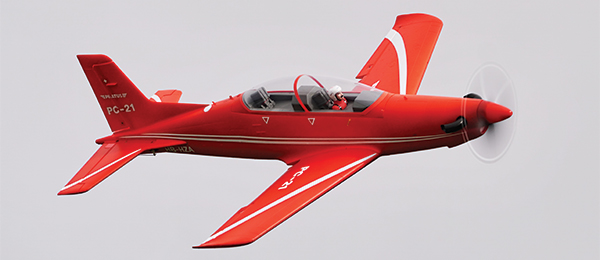
Written by Jon Barnes Step up to an advanced trainer Abridged product review Photos by the author Read the full product review in the January 2016 issue of Model Aviation.
Bonus video
Specifications
Model type: Semiscale electric Skill level: Intermediate Wingspan: 43.3 inches Wing area: 362.7 square inches Length: 48.6 inches Weight: 59 ounces Power system: Brushless electric Radio: Spektrum DX9 2.4 GHz DSMX nine-channel transmitter Construction: EPO 52 foam Finish: Water-based paint Street price: $209.99Test-model details
Motor used: 750 Kv brushless 3541 outrunner Speed controller: 40-amp brushless ESC with BEC Battery: 14.8-volt 4S 2,600 to 3,300 mAh LiPo Propeller: 10 x 7 five blade Radio system: Spektrum AR6115e DSM2 six-channel receiver Ready-to-fly weight: 60 ounces Flight duration: 5 to 7 minutesPluses
• The EPO 52 foam features a noticeably dense cell structure and is extremely smooth. • The water-based Pilatus Red paint used on the PC-21 results in an attractive, semimatte finish. • The included five-blade propeller mimics that used on the full-scale Pilatus PC-21. • Lightning-quick, g lueless assembly and factory-installed flaps and electric retracts.Minuses
• The plywood battery tray is mounted too far aft; using it as the location for the flight battery results in a tail-heavy model. • Imprecise ground handling and steering caused by the nose gear’s excessive side play on its axle.Abridged product review
FMS Models manufactures an amazing variety of exciting, electric-powered, foam-composition models. With the core of its product line focused squarely on several sizes of warbirds, many modelers will be pleasantly surprised to see the release of a 43.3-inch wingspan Pilatus PC-21. This Swiss-manufactured, turboprop-powered, full-scale airplane is used as an advanced trainer and is often the last aircraft flown by a pilot before transitioning into a high-performance, turbine-powered jet. Appropriately enough, the 1,600 hp Pratt & Whitney Canada PT6A-68B turboprop engine that powers the PC-21 gives the airplane performance capabilities that rival many turbine-powered jets. Signature features of this swept-wing monoplane include a large-diameter five-blade propeller, stepped tandem seating configuration, and advanced cockpit avionics.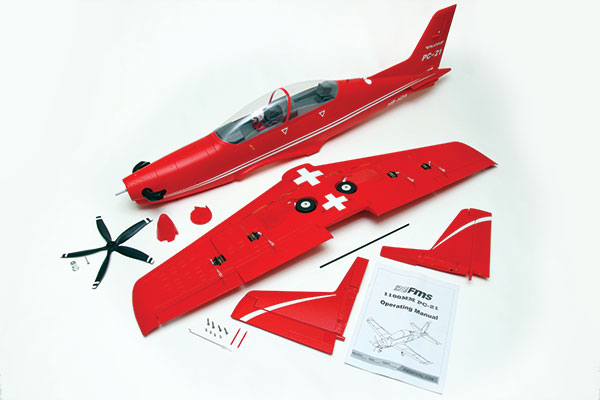
FMS recently switched to a water-based paint. The semimatte finish of the Pilatus Red paint used on this model is smooth and crisp.
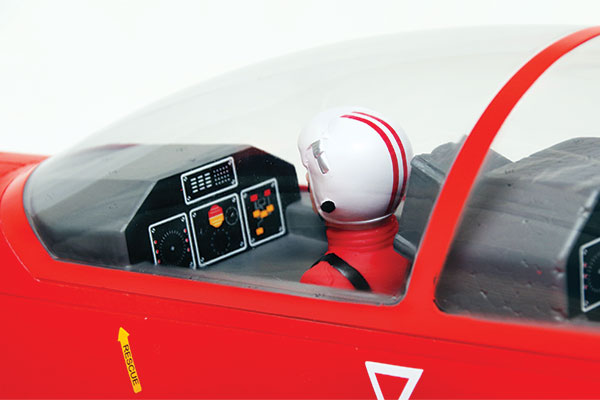
Although it’s a two-seat advanced trainer, FMS includes only one pilot figure. Multicolored cockpit graphics represent the advanced avionics and glass panels of the full-scale airplane.
Although the PC-21 model produced by FMS spans merely 43.3 inches, its 48.6-inch length causes it to present as a larger model. Significant features included with this Plug-N-Play model include electric retracts with gear doors and covers, plastic exhaust details, recessed flaps, and a preinstalled brushless electric power system. FMS deserves credit for including a cool-looking, scale outline-enhancing five-blade 10 x 7 propeller and spinner. Modelers need only to supply a minimum six-channel radio system and a 4S 14.8-volt 2,600-3,300 mAh LiPo flight battery to have the PC-21 ready for its first flights. The EPO 52-composition airframe components come out of the box prefinished in a luscious Pilatus Red paint scheme. The white, factory-applied graphics include several Swiss crosses and a variety of subtle and flowing stripes and swoops.
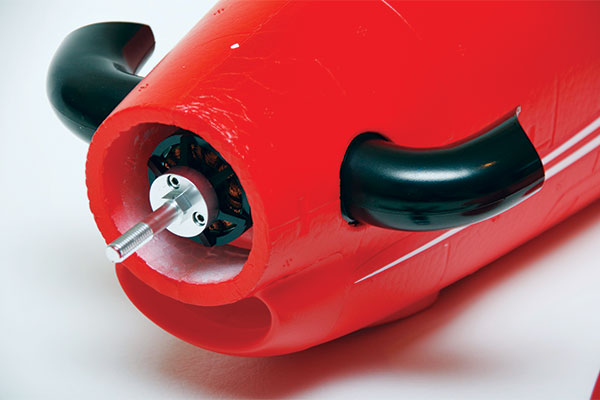
A pair of plastic exhaust stacks simulate those used by the Pratt & Whitney turboprop engine on the full-scale PC-21.
Flying
A conspicuously designed plywood battery tray, equipped with two factory-installed hook-and-loop retention straps, is positioned near the PC-21’s recommended center of gravity (CG); however, positioning a 4S LiPo flight battery of any size within the recommended range of 2,600 to 3,300 mAh on this plywood tray results in a tail-heavy model. Achieving the factory-defined CG requires that the battery be shifted substantially forward. There is ample space within the fuselage to allow this, although doing so results in only one of the two hook-and-loop straps effectively securing the flight battery in place. Pilots will probably want to add a supplemental piece of surface-mounting hook-and-loop material to secure the forward end of the battery in place. The electric retracts used on the PC-21’s tricycle landing gear feature full gear doors on the nose gear and partial gear covers on the mains. FMS nicely engineered an innovative spring-loaded teeter bar mechanism that cleanly pulls the twin nose gear doors closed as the gear retracts. Tricycle-gear-equipped models are known for their precise and predictable ground handling.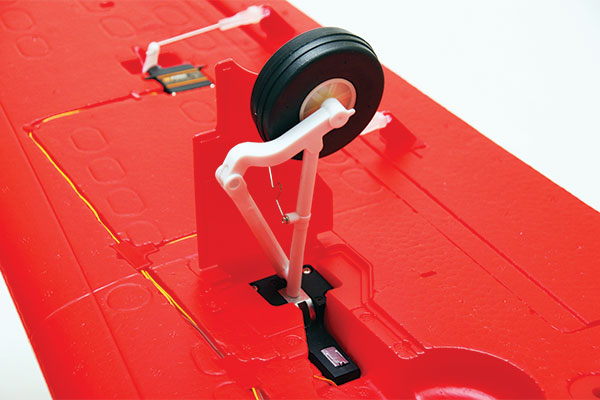
The main gear features outer gear doors and plastic faux trailing link struts.
The wheel/hub used on the PC-21’s nose gear is narrower than the space between the nose gear forks. This allows the nose gear to shift laterally on the axle when under load, which makes for slightly erratic tracking during a takeoff run. A few small shimming washers are all that are required to inhibit this undesirable characteristic. This model’s inflight tracking and stability in calm weather are impressively tight and true. Much of this can be attributed to the longer-than-typical tail moment of this airframe. Aerobatics performed with this model are smooth, graceful, and flowing. Although the wing cube loading number, calculated using the factory-supplied data, intimates a more heavily loaded model, the PC-21 flies lightly and feels floaty in the air.
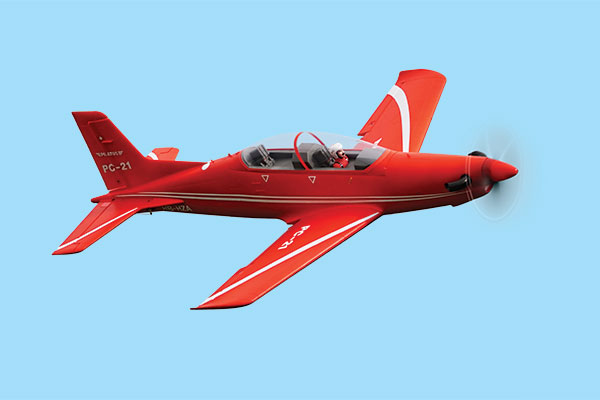
The included split flaps allow pilots to execute scalelike takeoffs and landings.
A model’s speed is always relative and somewhat subjective to the proficiency of the pilot flying it. Having noted that, less advanced pilots will assuredly find the model’s top speed sufficient and satisfying. More advanced pilots might, however, find themselves wishing for a little more. Multiblade scale propellers typically do not offer the most effective method of propelling a model across the sky with maximum velocity. Pilots who place a premium on making a model look as scalelike as possible will, however, gladly trade a few miles per hour of speed on the top end for the more accurate scale aesthetics offered by the FMS ultracool-looking five-blade propeller and red spinner! The five-blade, scimitar-style propeller used on the full-scale PC-21 is one of the defining identifiers of the airplane. A PC-21 model simply has to come equipped with a five-blade propeller to be taken seriously!
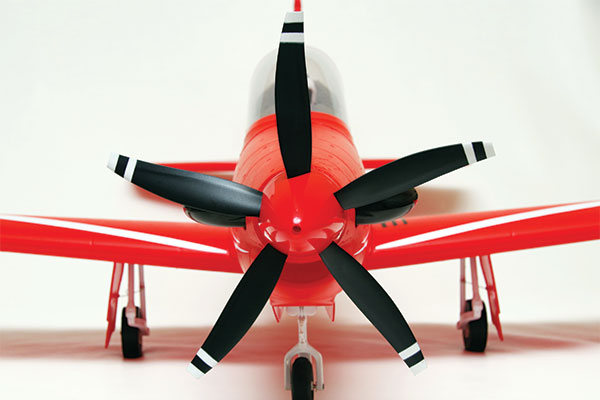










1 comments
would look good in my rc room
Add new comment